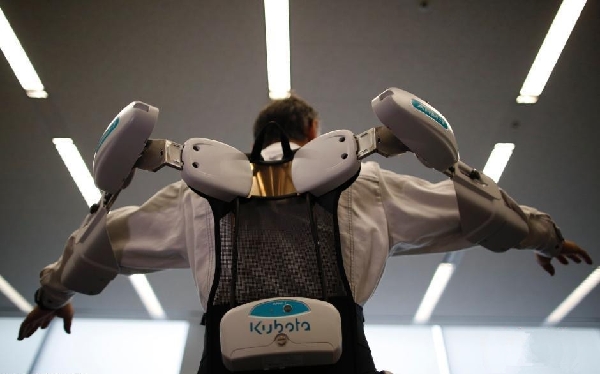
The waning year's advances in computer hardware and software, mechanical devices, sensors and artificial intelligence brought the world another step closer to the robotic future.
Electric cars were a big hit in 2015. Most large manufacturers introduced higher mileage models; some, such as Honda, pushed for alternate energy sources.
"We want to create a society that produces uses, and connects with hydrogen power," said the company's CEO, Tahakiro Hachigo.
Self-driving vehicles were also getting closer to everyday use. Even an autonomous truck, built by Mercedes, demonstrated its ability to safely navigate on a busy highway.
Wolfgang Bernhard, head of Daimler AG's trucks and buses division, showed how he could "take my hands off the wheel and, as you can see, the steering is smooth and the vehicle remains on track."
3-D printing ideas abound
On another front, 3-D printing technology has emerged as a cheaper way of manufacturing almost anything – from pastries to cars.
Divergent Microfactories, a startup company in Palo Alto, California, rolled out a 3-D printed chassis that weighs "only 102 pounds and has the same strength and safety protection as a frame made out of steel," chief designer Brad Balzer said.
The 3-D technology soon could play a role in resolving the global housing shortage, said Ma Yihe, CEO of China's WinSun Decoration Design Engineering Co.
"We use urban construction waste, mine tailings and urban solid wastes as raw materials," said Ma, whose company is headquartered in Shanghai. "We sort them by category and we transform them into a special printing ink."
Robots step forward
Robots also gained new ground, serving as human-like receptionists and robotic barmen or providing exoskeletons that help paralyzed people walk again.
Cheng-Hua Wu, an inventor for Taiwan's Industrial Technology Research Institute, touted the Walking Assistive Exoskeleton Robot as a potential boon to people with severe spinal cord injury, for instance.
Certain patients paralyzed from the chest down "are able to use our robot to stand, walk and sit down," Cheng-hua said. The device, made of aluminum and carbon fiber, weighs 20 kilograms (44 pounds).
Mind-controlled prostheses continue to promise great help for amputees.
The Icelandic firm Ossur introduced a bionic prosthetic leg that's paired with a tiny sensor placed in residual tissue. The sensor conducts electrical impulses from the amputee's brain to the bionic leg, allowing a more natural gait.
"We put sensors into the muscles, and the muscles would pick up the signals, and the signals move their way into the prosthetics, and then the prosthetics react as your brain wants," said Thorvaldur Ingvarsson, an orthopedic surgeon and Ossur's research director.
High-flying drones
Drones also made a big mark in 2015. Pilotless floating and flying vehicles have started exploring marine hydrology and biology, fighting big-game poachers in Africa, helping farmers survey and analyze their crops, and even inspecting large aircraft for possible damage.
Meanwhile, software developers are finding more and more practical uses for smartphones.
Samuel K. Sia, an associate professor of biomedical engineering at Columbia University, helped develop an inexpensive accessory that can detect several infectious disease markers from a droplet of blood in just 15 minutes.
"Instead of doing a blood draw and getting that sample sent to a lab, you can actually [analyze] it on the spot with just a finger prick of blood and you get the result in 15 minutes with a very similar quality as doing the test in a lab," Sia said of the device. A pilot model is being used to test for sexually transmitted diseases including HIV and syphilis.
Virtual reality also made big splash in the gaming industry and beyond with sophisticated headsets that transport users to different worlds.
"Virtual reality is definitely the most exciting technology in the industry right now," said Jon Hicks, a journalist working for the Gamer Network.
Also worth noting: In 2015, Microsoft introduced the newest version of the most popular operating system, Windows 10. For the first time, the company made the OS available for download free of charge.
Vocabulary
exoskeleton:外骨骼
orthopedic:整形外科的
來源:VOA
編輯:丁一
關注和訂閱


電話:8610-84883645
傳真:8610-84883500
Email: languagetips@chinadaily.com.cn